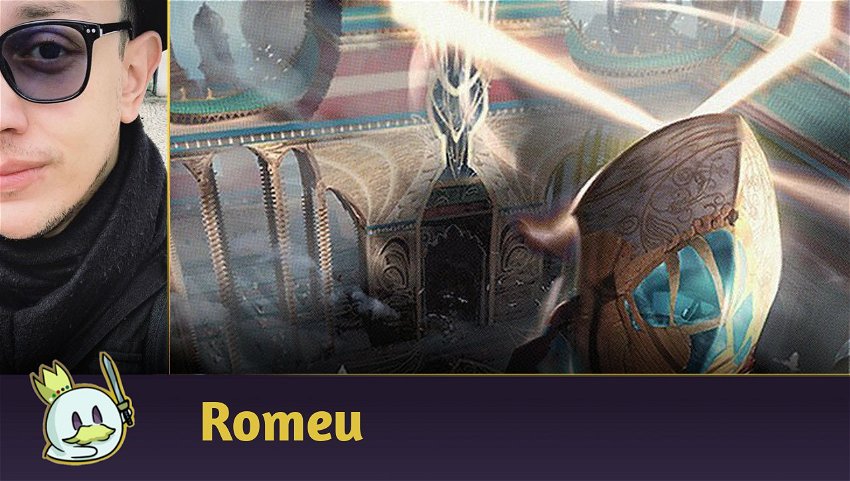The banlist updates are finally out, and in one of the most significant maintenance of the year, with the departure of cards that define pillars of three competitive formats, and the unbanning of one of the game's most controversial artifacts for Pioneer.
Metagame will certainly be impacted by these changes this year-end, and in this article, we evaluate the potential of this banlist and how formats can adapt in the coming weeks!
Pioneer
Banned

Ad
Unbanned

The most controversial changes in this update were in Pioneer, where not only did we have two cards banned, but they also unbanned one of the most controversial artifacts in the format.

Geological Appraiser's ban was spot on. The new creature from Lost Caverns of Ixalan guaranteed a one-card combo as early as the third turn, of which was nearly unbeatable for a dozen strategies. It didn't take a week for the Metagame to adapt, and it became clear that Geoform, as its deck became known, would twist the competitive environment around it.
If anything is surprising about this ban, it's that it was the only card from the deck that left the format.

Quintorius Kand also enables a one-piece combo alongside Spark Double and Clever Impersonator, which can copy the Planeswalker and activate its Discover ability to find another copy and establish a loop that will lead its controller to victory.
It seemed clear that Quintorius would not be banned after his deck had a 38% winrate during the Regional Championships in recent weeks. This rate is enough for us to consider that the strategy is much worse than Geoform and has more response and interaction windows, given that it is one turn slower than its predecessor, in addition to opening up more deckbuilding concessions.
The problem is how Quintorius Kand is the next card that enables a one-piece combo that Geoform players will try to break out of. Therefore, while banning it was not expected, it was preferable that its consistency was reduced by removing Trumpeting Carnosaur from the format for the general health of the Metagame.

Let's be honest: no one liked playing against Karn, the Great Creator. His potential to seek any answer while single-handedly locking down cards like Witch's Oven, Esika's Chariot, Reckoner Bankbuster and Parhelion II created more frustrating experiences than fun games. But should this be a criterion for banning cards?

This is not the first ban caused by the fun factor. For example, Cauldron Familiar was banned from Standard due to the bad experience of combining it with Mayhem Devil and Witch's Oven in Magic Arena. Should this combo, then, also be banned from Pioneer because it is not fun for creature-based strategies?
Should Greasefang, Okiba Boss then be banned for its potential to win the game as early as the fourth turn? Or do we ban Gleeful Demolition for the explosive plays it allows for Boros Convoke? Or remove Lotus Field and/or Thespian's Stage from Pioneer since it focuses on a non-interactive game proposal? Where is the line between what is healthy, and what is not, for Pioneer?
This line seems simple in some cases: when they banned Inverter of Truth, Walking Ballista, Underworld Breach, and Kethis, the Hidden Hand, Wizards left a clear sign of how consistent and hard-to-interact combos are a warning for the format - so Geoform's ban is not surprising. But in other cases, like Karn, the Great Creator, this line is not clear because there are other unfun moments that goes beyond it.
Ad

As I mentioned in my article where I speculated about the bans, while Karn is, in fact, one of the design errors of F.I.R.E.'s philosophy in War of the Spark, the problem with Mono Green Devotion is how the archetype manages to establish an abusive amount of mana to cast the Planeswalker, search from a Pithing Needle to a Portal to Phyrexia and cast the artifact on the same turn - the whole problem is how letting it resolve means both cards will probably resolve - and the culprit is Nykthos, Shrine to Nyx.
Nykthos is also responsible for invalidating any other Big Mana archetype. Why should I speed up my turns and land drops when I can just generate eight or more mana as early as turn four while creating an efficient, uncompromising board position?
Overall, it's good that the land remained in the format - Rakdos Midrange needs decks that can put it in check. However, there will be a time in the future where Nykthos, Shrine to Nyx stars another troublesome archetype, and when that time comes, it may become the target of a ban.

Smuggler's Copter was on my "Dangerous Unbans" list in the last article, which hasn't changed: the vehicle is too efficient and on too many lists to not be a potential threat to the Pioneer's health.
Its unban is big news for a dozen archetypes: Creature-based Aggro certainly benefit from the artifact, cards like Inti, Seneschal of the Sun can be pretty absurd with it, and Midranges might consider whether they want to keep Reckoner Bankbuster on their lists.
It's difficult to assess how far Smuggler's Copter can go, but just to name a few archetypes that can benefit from it: Gruul Vehicles, Rakdos Sacrifice, Spirits, Ensoul, Rakdos Midrange, Flash and Aggro which are in Tier 2.
As for the winners and losers of these changes, my bets are that Rakdos Sacrifice will be an excellent meta call in the coming weeks, as many players will test Smuggler's Copter and its core is made to prey on creature archetypes. Furthermore, it is also excellent for playing with the vehicle (crew the Copter with Cauldron Familiar to sacrifice it afterward), and has an efficient card pool to respond to the rest of the Metagame - in addition to no longer needing to worry about Karn, the Great Creator.
Rakdos Midrange is another winner, as its natural predator has lost strength. However, the value of "Karn Toolbox" also challenged other archetypes that played above it, such as Niv-to-Light and Omnath Beanstalk.
Izzet Phoenix is a little less favored because its match against Mono Green was one of its advantages, and the match against Rakdos Midrange and Goodstuff Piles is not the best. Furthermore, Smuggler's Copter is an additional headache when planning an attack.
Boros Convoke and Mono White Humans don't seem to want to run Smuggler's Copter, but can be caught in the "copter decks" and "counter-copter decks" meta in the next two weeks. Greasefang, Okiba Boss might benefit from the new artifact, but it already has so many cards that discard Parhelion II more efficiently that I'm skeptical about the new vehicle's potential in it - plus, it also will be caught by the addition of artifact hate in the coming weeks.
Ad
Amidst the chaos, Lotus Combo seems favored if the environment becomes more focused on board interaction instead of discards and counterspells, while Azorius Control could lose space due to Georofm's ban combined with the fact that Smuggler's Copter enables more potential threats that evade certain sweepers and amplify Aggro's filtering.
Modern
Banned

After two long years, a direct intervention finally takes place in the most problematic cycle that Modern Horizons II has brought us, the Evokers.
As I mentioned in my article where I discuss the Elementals' predominance in the format, Fury was the most played creature in Modern and the second most played spell, behind only Chalice of the Void.
Its presence in the Metagame was, for months, the target of criticism from many players due to how it was the only card in the cycle that generated an efficient pitch exchange, in addition to being a powerful threat on his own. However, its mechanics were tolerable to the point where players decided to pair it with Feign Death and Undying Evil to establish a three-turn clock that also cleared the opponent's board.

When Orcish Bowmasters started punishing card selection from archetypes like Izzet Murktide, Rakdos Evoke soon became the best deck in the format. Grief ensured that the opponent had interaction problems, while Fury ensured they could not overextend the board. Added to the fact that Fury also interacts with another recently released staple, Up the Beanstalk, its ban was already expected and the most logical thing for the format's health.

Speaking of Up the Beanstalk, the Wilds of Eldraine enchantment was also banned, and most players certainly weren't expecting it to go away. Alongside Solitude, Fury, Leyline Binding and Lorien Revealed, it became a staple on Four-Color Goodstuff and even enabled Cascade Beanstalk, which sought to use Shardless Agent and Bloodbraid Elf to fetch the enchantment.
As Wizards' announcement explained, Up the Beanstalk's power level is proven from the moment Cascade players opt for it over Crashing Footfalls or Living End as primary targets for Shardless Agent.
The expectation is that Fury's departure would be enough to also weaken Beanstalk lists, but it appears that Wizards chose to respect its potential to break resource symmetries with Solitude and other cards that bypass mana costs.
So who won with these bans? The main winners are creature-based combos:

If we look at the Modern pre-ban Metagame, we'll notice that the only creature-based combos at the top are Golgari Yawgmoth and Hammer Time. The reason is that, in addition to being explosive and/or adaptable to the environment they find themselves in, they were also resilient against Fury: Hammer Time could play one threat at a time or hide behind protections and Inkmoth Nexus to deal with it, and Golgari Yawgmoth needed the elemental to be cast with essential timing to avoid a quick defeat.
Ad
Now, without a maindeck sweeper that is also a threat, other creature-based combos, such as Samwise Gamgee with Cauldron Familiar, or Heliod Company, can gain space in the competitive scene by being able to build an efficient board that allows them to play on the "Aggro-Combo" plan without so much risk in Game 1.

On the other hand, I will be surprised if synergy-based Aggro return to the Metagame. Yes, its greatest nemesis was just banned, but Modern is still a very hostile format for cards that offer little individual value: Orcish Bowmasters and Wrenn and Six still put the format's X/1s at check, decks like Temur Rhinos and Hammer Time can execute their game plan too quickly, Prowess lists can gain more space to play under and the rise of Golgari Yawgmoth will force players to use more efficient removal and/or set aside more slots for creature matchups.
All the cases mentioned above greatly hinder the path of aggressive strategies based on synergies between creatures. Today, Modern is not a fair format, and archetypes like Merfolks, Humans or Death & Taxes play and will continue to play too fair for this Metagame.
Pauper
Banned

Since the past year, Pauper has transformed into a high-speed format, and much of it is due to the presence of the three archetypes that constitute the Metagame's pillars today: Kuldotha Red, Dimir Terror and Affinity - all three capable of ending the game in a few turns, or creating an irreversible board state.
Monastery Swiftspear is, in fact, part of the problem that made Kuldotha Red one of the most polarizing games in the format: its explosive entries with Burn and card advantage effects, such as Wrenn's Resolve and Reckless Impulse made it the ideal clock to play under different strategies and punish bad starting hands.
This led, as the PFP article rightly pointed out, to the point where players needed to dedicate too many slots to dealing with red, either with lifegain or with multiple copies of Blue Elemental Blast and Hydroblast, which limited the space to interact with other matchups.
This ban is the right direction if PFP wants to address Pauper's speed issues, but would it be enough to improve the format?

Kuldotha Red still has the fastest clock in the format and an absurd explosive potential alongside _____ Goblin and Goblin Bushwhacker, in addition to having gained a "Goblin Guide we have at home" with Goblin Tomb Raider. To remove the free win potential, the "Name-Sticker" Goblin should have been banned alongside Monastery Swiftspear.
There will still be many strategies that will need to invest in keeping its clock in post-sideboard games, however, without one of its "free-win buttons", Kuldotha Red is an excellent archetype to have among the best decks in the format, and the ideal "fun police" for the Pauper Metagame.
Ad
And the biggest problem now is not the permanence of one or more Kuldotha Red cards in the format, but rather Affinity.

Affinity is, today, divided into two categories: Aggro/Tempo with the Azorius version, which seeks to capitalize on All That Glitters's potential to perform a "combo-kill", and Midrange with the Grixis version, which abuses artifacts with relevant ETB and LTB effects alongside Deadly Dispute - Before Monastery Swiftspear's downshift in Double Masters 2022, Affinity was Pauper's best strategy by a wide margin.
It's important to remember how many of the problems with red decks in recent months were also felt against Affinity before the downshift.

There was a time when players would invest eight or more slots in their lists to deal with Affinity, even with copies of cards in the maindeck that would be virtually dead in other games. Without Swiftspear, it is possible that the Metagame will shift back towards an environment where Affinity is the predominant strategy, and players will need to dedicate more space on their Sideboard just for this matchup.

Snuff Out improves with the ban and can serve to hold back the more explosive versions with All That Glitters and strategies like Caw Gates and Black Gardens certainly have the elements to try to play over of the Midrange version.
Therefore, it is possible that this "predominance" ends up shaping the Metagame in a way that establishes matches with greater attrition, which would open up space for Kuldotha Burn to prey on these lists, which would open up space for the Mono Blue versions of Tolarian Terror decks to appear and, in the end, it is possible that Pauper will gain a cyclical environment again... Or we will discover another problem in the Metagame in less than 30 days.
Conclusion
That's all for today.
If you have any questions or suggestions, feel free to leave a comment!
Thanks for reading!








— 코멘트0
첫 댓글을 남겨보세요